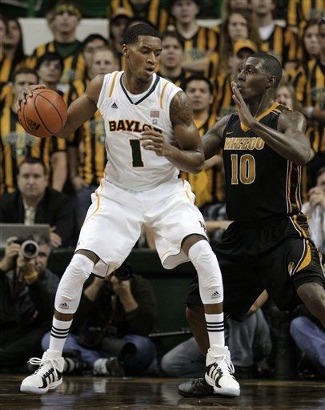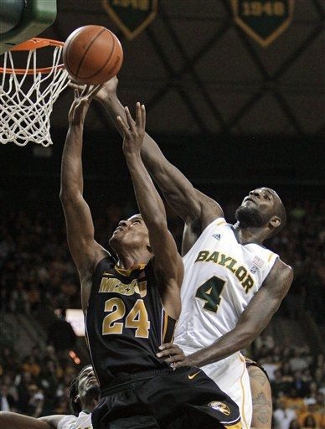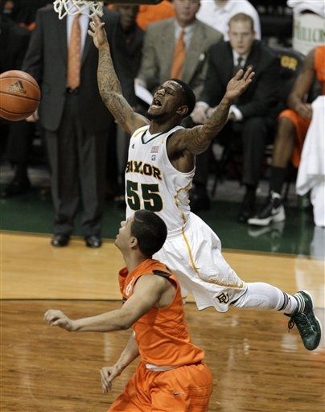Ferrell Center | Waco, TX | Tip: 12:05 P.M. CT | TV: CBS LRT Consecutive Game #207 The Texas Longhorns took care of business on Tuesday night, earning a win they had to have over Iowa State. The Horns have spent most of the season positioned squarely on the proverbial NCAA tournament bubble, but another loss against a marginal RPI Top 50 team like the Cyclones would surely have darkened the postseason outlook for the Horns. Today’s game against a deep, athletic Baylor team ranked in the Top 10 is certainly not a must-win. Even the most optimistic of Longhorn fans likely realizes just how difficult it will be for Texas to pull off a monumental road upset in Waco this afternoon. But while no one is expecting the Horns to march into the Ferrell Center and shock the nation, an improbable victory would provide a massive boost to Texas’ NCAA tournament chances. By the numbers The Bears roared out to a 17-0 record this season, the best start in school history. Baylor had close calls during that historic stretch, needing a clutch three and overtime to beat West Virginia in Las Vegas, while winning by just a bucket at Kansas State and against Mississippi State in Dallas. The Bears also won by three against BYU at the Marriott Center, one of the toughest venues in all of college basketball. With 11 games left until the conference tournament even begins, this Baylor team is already well-prepared for high-pressure situations.
Perry Jones III and Baylor are among the best in the nation Baylor has one of the ten most efficient offenses in college hoops, scoring 1.168 points per possession. Even against the tougher opposition in Big 12 play, the Bears have only seen that number dip to 1.149, the second-best mark in the league. Baylor’s success hinges on an incredibly high effective field goal percentage of 55.6%, a number boosted by the team’s deadly accuracy from long range. Six of the eight members of Baylor’s core rotation have made at least a third of their threes in league play, and the team has knocked down 41% of their long-range looks this season. With a big, athletic frontline, the Bears also extend possessions when they happen to miss shots. The team’s 37% mark for offensive rebounding ranks in the Top 40 nationally, and that percentage has actually ticked up slightly in league games. On defense, that length and athleticism also leads to a lot of blocked shots, and the team’s 15.1% swat percentage is ranked 14th in the nation. Where that height and athletic ability fails the Bears is on the defensive glass. Baylor is actually one of the 100 worst teams in Division I when it comes to securing defensive boards, as the team allows opponents to reclaim 34.3% of their misses. Under Scott Drew, the Bear defense has been synonymous with the 2-3 zone, although this year they have mixed in much more man and even a 1-3-1 look. With the team not used to having box out assignments in the zone, they have had difficulties remembering to put a body on opposing rebounders when playing man. For a Texas team that is actually very good at grabbing offensive boards, this could be huge. Meet the Bears While the Baylor lineup is full of highly-touted recruits and potential NBA lottery picks, the biggest impact this season has come from a junior college transfer. A player of the year at the JUCO level, Pierre Jackson (No. 55) has earned a starting spot in the team’s last two games, and it’s easy to see why. The Baylor offense is a completely different animal with Jackson on the floor, as he dices up defenses with his dribble penetration and always seems to put his teammates in the perfect position to score. In conference play, Jackson is nearly averaging an unconventional double-double, posting 14 points and nine assists each night. In addition to being able to put the ball on the floor and thread the needle with ridiculous passes, the former Southern Idaho standout is also practically automatic from long range. In Big 12 games, Jackson has drilled 53.3% of his looks from behind the arc. Joining Jackson in the backcourt is another guy who cans it from deep, Canadian product Brady Heslip (No 5). A transfer from Boston College, Heslip has taken 82% of his shots from downtown this season. With a 47% success rate from three-point range, it’s hard to fault the guy. Although Heslip doesn’t shoot it often from inside the arc, he has shown a deft touch when defenses run him off the perimeter. He can knock down the soft floater, and has even gone old-school with a few banked pull-up Js. The name that all fans are likely familiar with is sophomore star Perry Jones III (No. 1). Known as PJ3, the 6’11” forward is an all-around stud who has the NBA scouts drooling. He’s played every position in his career, so he’s the deadly breed of big man with great handles who can also knock down jumpers all over the floor.
Quincy Acy’s shot blocking protects the lane The main knock on PJ3’s game is that he disappears in the clutch, deferring to teammates when he should be demanding the rock. Critics made this claim following the team’s losses to Kansas and Missouri, but they also failed to point out that he injured his ankle during the game against the Jayhawks. Back to full strength on Tuesday night, PJ3 posted a 21-point, 12-rebound line against the upset-minded Sooners. Alongside PJ3 in the Baylor frontcourt is senior big man Quincy Acy (No. 4), a high-energy guy who knows how to rock the rim. In his career, Acy has 219 dunks, which account for 51% of his made field goals. He’s often the recipient of great dump-offs from Jackson, but will also fiercely throw down an offensive rebound when the opportunity presents itself. The Bears also run a simple lob play on baseline inbounds situations to get Acy dunks, something they have been doing all four years he’s been on campus. He’s also a force inside on defense, swatting more than two shots per game for a block percentage of 8.4%, a mark that is just outside the Top 50 nationally. Freshman forward Quincy Miller (No. 30) rounds out the starting five for Baylor, and he provides yet another all-around scoring threat. On a team without PJ3, Miller would likely be the go-to guy, but at Baylor he’s an incredibly-talented second option. He had major knee surgery during his senior year of high school, so his first step still isn’t quite as explosive as it once was, but he can still score in bunches with an array of moves and a jump shot that’s good past the arc. In conference play, Miller is tops on the team with 15.3 points per game. Coming off the bench is point guard A.J. Walton (No. 22), who lost the starting job to Jackson. Known for his outstanding perimeter defense, Walton still averages around 20 minutes per game and will likely be tasked with shutting down J’Covan Brown when he’s on the floor. Walton has a steal percentage of 4.6%, which may not sound like much, but is actually the 25th-best individual mark in the nation. Senior forward Anthony Jones (No. 41) is another displaced starter, but he is playing his role perfectly on this deep team. He provides a lot of length for the back line of that Baylor zone, but also is a long-range threat that loves to camp out in the corner for kickouts on the offensive end. Jones has made roughly 31% of his threes so far on the season, and is also one of three Bears to have an individual offensive rebounding mark north of 10%. Sophomore guard Gary Franklin (No. 0) is a transfer from Cal who became eligible at midseason. He’s only playing about 11 minutes per game in conference, and is essentially just a long-range catch-and-shoot threat. Sixteen of his 17 field goal attempts in Big 12 games have come from behind the arc, and he’s hitting at a 37.5% clip. Cory Jefferson (No. 34) rounds out the core rotation, playing about nine minutes per game against Big 12 opponents. He’s a long and lean 6’9″ forward who will undoubtedly lead the team in blocked shots before he graduates. Against UT-Arlington, he blocked seven shots in 25 minutes on the court. In 10 of the team’s first 17 games, Jefferson swatted at least two shots, but he has seen very little action over the last three contests. Keys to the game 1) Make second chances count – One of Baylor’s biggest weaknesses is on the defensive glass, which matches up perfectly with the Texas strength of offensive rebounding. The Longhorns must turn those second chances into points if they want to have any chance for an upset this afternoon. It will be even better if Texas can quickly turn those offensive boards into easy putbacks, as the Horns have really struggled in the half-court lately. 2) Get efficient contributions from Brown – A big reason for those half-court struggles has been the ball-dominating play of junior J’Covan Brown. In the team’s last three games, Brown is 18-of-70 from the floor (25.7%), having taken 40% of the team’s shots. When you consider that the Longhorns won one of those games and were in it until the final seconds against both Kansas and Kansas State, one can only wonder how Texas would have fared if Brown involved his teammates a little more.
Pierre Jackson can be forced into mistakes In addition to eating up possessions with a ton of missed shots, Brown’s one-man show also led to his teammates doing very little when he was off the ball. Most Longhorns stood around on offense, failing to make cuts or set screens, instead waiting for the junior guard to come back to the ball and shoot. If Texas wants to win this tough road test, they will have to get an efficient game from Brown that involves his teammates. 3) Rattle Jackson – When Pierre Jackson is on his game, Baylor is tough to stop. The quick, tiny guard can push the issue in transition, break down the defense in the halfcourt, and hit dagger threes with little separation from his man. That being said, he’s also shown a tendency to make mistakes, and to let those mistakes snowball. Jackson has picked up a fair number of charges on the season, so quality help defense can pin a few offensive fouls on him. In addition, his turnover rate of more than 30% is incredibly high for a point guard, oftentimes the result of him trying to do too much. The Longhorns don’t necessarily need to apply a ton of pressure on Jackson, but do need to play sound, team defense so they can capitalize when he tries to force things. |











